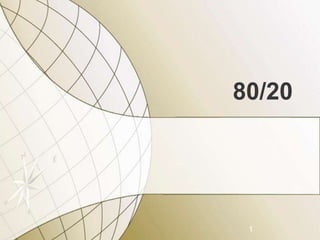80/20
- 1. 80/201
- 2. Overview ConceptPareto lawThe 80/20 Principle asserts that a minority of causes, inputs or effort usually lead to a majority of the results, outputs or rewards.The 80/20 Principle tells us that in any population, some things are likely to be much more important than others. A good benchmark or hypothesis is that 80 per cent of results or outputs flow from 20 per cent of causes, and sometimes from a much smaller proportion of powerful forces.2
- 3. ExamplesEveryday languageOver 99% of talk uses fewer than 20% of words.Movies4% of the films hold 85% of the revenues.20% of products makes 80% of salesIPODDistribution of world GDP, 1989 of Population Income:Richest 20% hold 82.7% Second 20% hold 11.7% Third 20% hold 2.3% Fourth 20% hold 1.4% Poorest 20% hold 1.2%3
- 4. 80/20 History1897Italian economist Vilfredo Pareto (1848â1923)1949Zipfâs Principle of Least EffortZipfâs principle : Resources (people, goods, time, skills or anything else that is productive) tended to arrange themselves so as to minimize work, so that approximately 20â30 per cent of any resource accounted for 70â80 per cent of the activity related to that resource.1951Joseph Juran: Quality Revolution of 1950â90He made what he alternately called the âPareto Principleâ and the âRule of the Vital Fewâ virtually synonymous with the search for high product quality.4
- 5. Why?Why should you care about the 80/20 Principle?The principle applies to your life, to your social world and to the place where you work. Understanding the 80/20 Principle gives you great insight into what is really happening in the world around you.Our daily lives can be greatly improved by using the 80/20 Principle.Each individual can be more effective and happier. Each profit-seeking corporation can become very much more profitable. 5
- 6. How?Analytical 80/20:Requires to separate sets of data and a clear relation between them.The use of Substitution to increase the effect on the overall outcome.The use of mimicking and replications of efficient resources.Thinking 80/20:Mined setChange initiatorBased on the Vital Few6
- 8. 80/20 AnalysisPreciseQuantitativeRequires InvestigationProvides FactsHighly valuable8
- 9. Thinking 80/20FuzzyQualitativeRequires ThoughtProvides InsightHighly valuable9
- 10. In BusinessInnovative look at data analysisReset Priorities According to outcomeRe-focus based on customers highest contribution towards outcomeFocus product development on top 20% products required by customersOthers..10











